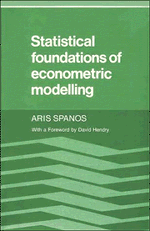Book contents
- Frontmatter
- Contents
- Foreword by David Hendry
- Preface
- Acknowledgements
- List of symbols and abbreviations
- Part I Introduction
- 1 Econometric modelling, a preliminary view
- 2 Descriptive study of data
- Part II Probability theory
- Part III Statistical inference
- Part IV The linear regression and related statistical models
- References
- Index
2 - Descriptive study of data
Published online by Cambridge University Press: 01 June 2011
- Frontmatter
- Contents
- Foreword by David Hendry
- Preface
- Acknowledgements
- List of symbols and abbreviations
- Part I Introduction
- 1 Econometric modelling, a preliminary view
- 2 Descriptive study of data
- Part II Probability theory
- Part III Statistical inference
- Part IV The linear regression and related statistical models
- References
- Index
Summary
Histograms and their numerical characteristics
By descriptive study of data we refer to the summarisation and exposition (tabulation, grouping, graphical representation) of observed data as well as the derivation of numerical characteristics such as measures of location, dispersion and shape.
Although the descriptive study of data is an important facet of modelling with real data in itself, in the present study it is mainly used to motivate the need for probability theory and statistical inference proper.
In order to make the discussion more specific let us consider the after-tax personal income data of 23,000 households for 1979–80 in the UK. These data in raw form constitute 23,000 numbers between £1000 and £50,000. This presents us with a formidable task in attempting to understand how income is distributed among the 23,000 households represented in the data. The purpose of descriptive statistics is to help us make some sense of such data. A natural way to proceed is to summarise the data by allocating the numbers into classes (intervals). The number of intervals is chosen a priori and it depends on the degree of summarisation needed. In the present case the income data are allocated into 15 intervals, as shown in Table 2.1 below (see National Income and Expenditure (1983)). The first column of the table shows the income intervals, the second column shows the number of incomes falling into each interval and the third column the relative frequency for each interval.
Information
- Type
- Chapter
- Information
- Statistical Foundations of Econometric Modelling , pp. 23 - 30Publisher: Cambridge University PressPrint publication year: 1986
